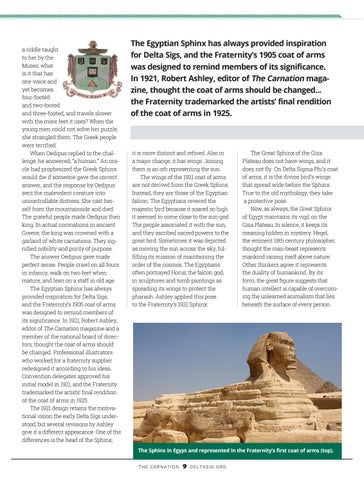a riddle taught to her by the Muses: what is it that has one voice and yet becomes four-footed and two-footed and three-footed, and travels slower with the more feet it uses? When the young men could not solve her puzzle, she strangled them. The Greek people were terrified. When Oedipus replied to the challenge, he answered, “a human.” An oracle had prophesized the Greek Sphinx would die if someone gave the correct answer, and the response by Oedipus sent the malevolent creature into uncontrollable distress. She cast herself from the mountainside and died. The grateful people made Oedipus their king. In actual coronations in ancient Greece, the king was crowned with a garland of white carnations. They signified nobility and purity of purpose. The answer Oedipus gave made perfect sense. People crawl on all fours in infancy, walk on two feet when mature, and lean on a staff in old age. The Egyptian Sphinx has always provided inspiration for Delta Sigs, and the Fraternity’s 1905 coat of arms was designed to remind members of its significance. In 1921, Robert Ashley, editor of The Carnation magazine and a member of the national board of directors, thought the coat of arms should be changed. Professional illustrators who worked for a fraternity supplier redesigned it according to his ideas. Convention delegates approved his initial model in 1921, and the Fraternity trademarked the artists’ final rendition of the coat of arms in 1925. The 1921 design retains the motivational vision the early Delta Sigs understood, but several revisions by Ashley give it a different appearance. One of the differences is the head of the Sphinx;
The Egyptian Sphinx has always provided inspiration for Delta Sigs, and the Fraternity’s 1905 coat of arms was designed to remind members of its significance. In 1921, Robert Ashley, editor of The Carnation magazine, thought the coat of arms should be changed... the Fraternity trademarked the artists’ final rendition of the coat of arms in 1925.
it is more distinct and refined. Also in a major change, it has wings. Joining them is an orb representing the sun. The wings of the 1921 coat of arms are not derived from the Greek Sphinx. Instead, they are those of the Egyptian falcon. The Egyptians revered the majestic bird because it soared so high it seemed to come close to the sun-god. The people associated it with the sun, and they ascribed sacred powers to the great bird. Sometimes it was depicted as moving the sun across the sky, fulfilling its mission of maintaining the order of the cosmos. The Egyptians often portrayed Horus, the falcon god, in sculptures and tomb paintings as spreading its wings to protect the pharaoh. Ashley applied this pose to the Fraternity’s 1921 Sphinx.
The Great Sphinx of the Giza Plateau does not have wings, and it does not fly. On Delta Sigma Phi’s coat of arms, it is the divine bird’s wings that spread wide before the Sphinx. True to the old mythology, they take a protective pose. Now, as always, the Great Sphinx of Egypt maintains its vigil on the Giza Plateau. In silence, it keeps its meaning hidden in mystery. Hegel, the eminent 19th century philosopher, thought the man-beast represents mankind raising itself above nature. Other thinkers agree it represents the duality of humankind. By its form, the great figure suggests that human intellect is capable of overcoming the unlearned animalism that lies beneath the surface of every person.
The Sphinx in Egypt and represented in the Fraternity’s first coat of arms (top). THE CARNATION
9
DELTASIG.ORG
